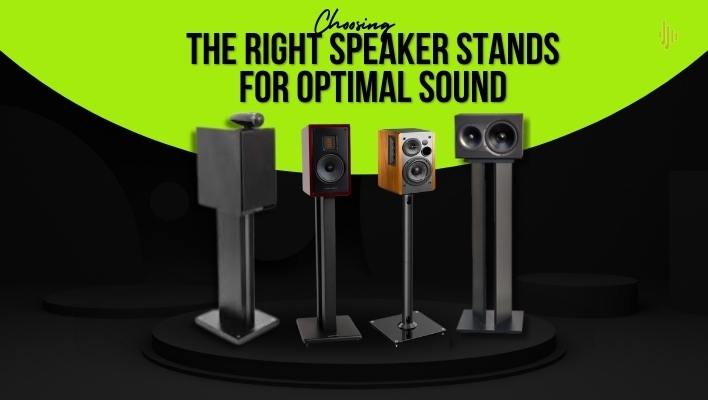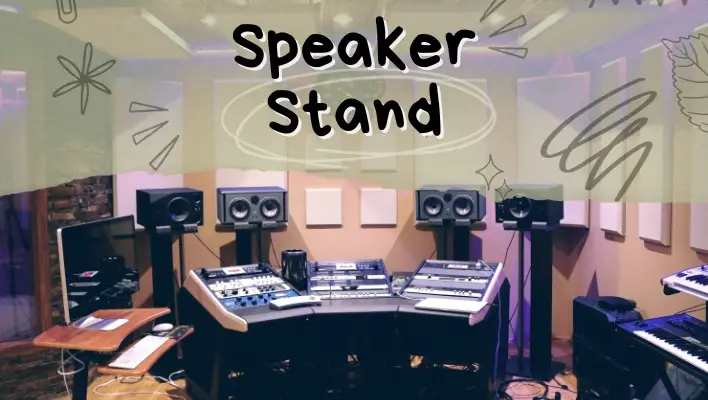The importance of speaker stands in sound quality cannot be overstated. These accessories go beyond visual appeal, and actively contribute to the holistic optimization of the audio experience. Many audio enthusiasts often overlook the importance of speaker stands, but these seemingly minor accessories play a critical role in optimizing the performance of your audio system.
Speaker stands are crafted with precision to hold speakers at an optimal height, resulting in clear and tangible improvements in sound projection and dispersion. Furthermore, they offer versatile height options to accommodate various speaker types and room configurations in audio playback and live performances.
Importance of Speaker Stands in Sound Quality
Speaker Elevation
The primary role of speaker stands is to elevate your speakers to an optimal height. This helps ensure that sound waves are directed at the ear level, which improves sound projection and dispersion. The elevation also helps overcome obstacles and reduces the impact of reflective surfaces.
Minimizing Vibrations and Resonance
Placing speakers directly on surfaces can result in unwanted vibrations and resonance. Speaker stands help provide isolating platforms, which prevent the transmission of vibrations from the speakers to surrounding surfaces. The result is a clearer and more defined sound experience that lets you fully appreciate the nuances of your favorite music.
Improved Bass Response
Elevating speakers off the ground helps maintain a consistent and powerful bass response. When speakers are placed on the floor, low-frequency sound waves may be absorbed or dispersed unevenly. Speaker stands provide a clear path for these low frequencies, preventing them from being lost or distorted.
Reduced Interference
Placing speakers directly on shelves or the floor often exposes them to reflections and diffractions that can compromise sound quality. Using speaker stands helps reduce interference from surrounding objects and surfaces, thereby ensuring a more faithful signal reproduction.
Precise Speaker Positioning
Achieving the ideal height and angle for your speakers is crucial for creating precise imaging and an immersive soundstage. Speaker stands offer the flexibility to position your speakers at ear level, which helps direct the audio output toward your ears. Having the tweeters at ear level allows you to experience the full spectrum of high-frequency details, resulting in a more accurate and balanced sound reproduction.
Aesthetic Appeal
Beyond their functional benefits, speaker stands contribute to the aesthetics of your listening space. With a variety of designs and finishes available, you can easily find stands that complement your room’s decor, which adds to the overall listening experience.

Types of Speaker Stands
I. Fixed Height Speaker Stands
Fixed height speaker stand, just as the name suggests, is a type of speaker stand designed to securely position speakers at a predetermined height. These stands offer stability and simplicity in audio setups, and you can use them in various applications such as home theaters, stereo systems, or multimedia configurations.
Advantages
- Simplicity- Fixed height speaker stands are easy to set up and use. This makes them a straightforward choice for users who prefer a hassle-free audio setup.
- Stability- Fixed speaker stands provide a stable and rigid platform for speakers with minimal vibrations.
- Durability- Fixed stands come with fewer moving parts, which allows them to provide a reliable, long-term solution for speaker placement.
- Suitability for fixed seating arrangements- Fixed speaker stands are well-suited for applications where the listening position and speaker height remain constant, such as in dedicated home theater rooms or setups with fixed seating arrangements.
- Cost-effective- Fixed speaker stands provide a budget-friendly solution, particularly for speakers with set listening height.
Disadvantages
- Lack of adjustability- The main limitation of fixed height stands is their inability to adjust the speaker’s height. This can be a drawback if flexibility in speaker placement is needed.
- Does not accommodate changes in setup- If you anticipate changes in your audio setup or plan to upgrade your speakers in the future, fixed height stands may not be the best option.

II. Adjustable Height Speaker Stands
Adjustable speaker stands are designed to provide flexibility in speaker placement by allowing users to customize the height, and sometimes the tilt of their speakers. These stands cater to individuals who need to adapt their audio setup to different room configurations, seating arrangements, and personal preferences.
Advantages
- Customizable height- The primary advantage of adjustable speaker stands is their ability to change the speaker’s height. This allows users to achieve an optimal listening experience and adapt to different room configurations.
- Adaptable to seating arrangements- Adjustable stands allow you to position speakers at the correct height, regardless of changes in seating arrangement or room layout.
- Optimal speaker placement-These speaker stands allow users to fine-tune the height of their speakers to achieve the best sound dispersion and imaging.
Disadvantages
- Complexity- Adjustable speaker stands are generally more complex than fixed height stands due to the mechanisms involved in height adjustments.
- Risk for instability- The adjustable components in these stands may introduce a potential point of weakness, leading to reduced stability.
- Aesthetics- While adjustable stands prioritize functionality, some designs may have a slightly less streamlined appearance.
III. Floor-Standing Speaker Stands
Floor-standing speaker stands are designed to elevate speakers off the floor to improve sound projection, enhance aesthetics, and provide stability. These stands are ideal for larger speakers and are commonly used in home theaters, hi-fi audio systems, and other setups where floor placement is not optimal.
Advantages
- Optimal height- Floor-standing speaker stands are designed to position speakers at an optimal listening height. This ensures that sound is projected at ear level for an immersive audio experience.
- Stability- Floor-standing speaker stands typically have a wider and heavier base. This construction provides enhanced stability and improved sound quality.
- Space efficiency- Floor-standing stands help save floor space by lifting large and heavy speakers off the floor.
- Built-in cable management- Most floor-standing stands come with built-in cable management systems. This helps to organize and conceal speaker cables for a neat appearance.
Disadvantages
- Space requirement- Floor-standing speaker tends to have a larger footprint, which can be a limitation in smaller rooms.
- Less Portable- Due to their size and weight, floor-standing stands are generally less portable
- Room aesthetics- Some users may find the size and presence of floor-standing stands in the room to be visually dominating.
IV. Desktop Speaker Stands
Desktop speaker stands are compact support systems designed to elevate smaller speakers to an optimal listening height on a desk or tabletop. These stands play a crucial role in enhancing the audio experience in near-field listening environments, such as desktop setups or small home offices.
Advantages
- Space efficiency- Desktop stands have a small footprint, making them ideal for limited desk space. They provide a practical solution for users who want to optimize their workspace without sacrificing audio quality
- Portability- Desktop speaker stands are generally lightweight and easy to move. This provides flexibility in speaker placement while allowing users to experiment with different setups
Disadvantages
- Limited height- These stands have limited height, but they are often sufficient for desktop setups.
- Weight capacity- Desktop stands may have a lower weight capacity compared to larger speaker stands.
V. Collapsible or Folding Speaker Stands
Collapsible or folding speaker stands are designed with portability and convenience in mind. These stands feature a design that allows them to be easily folded or collapsed after use. This design makes them suitable for users who require a mobile and space-saving solution for their audio setups.
Advantages
- Portability- The primary advantage of collapsible or folding speaker stands is their portability. These stands are designed to be easily folded, making them convenient for transportation to different locations or for users who rearrange their setup frequently.
- Space-saving design- When not in use, you can fold down the stands to a compact size for easy storage in smaller spaces.
- Easy setup and takedown- Collapsible stands typically feature a simple and quick setup process. This allows users to assemble or disassemble the stands within the shortest time possible.
Disadvantages
- Reduced stability- The folding or collapsible design may introduce some compromise in the stability of the stand. As such, users should ensure that the stands are adequately stable, especially when supporting larger or heavier speakers.
- Limited weight capacity- Collapsible stands may have a lower weight capacity compared to floor-standing options.
- Wear and tear- The folding mechanisms may be prone to wear and tear over time, especially with frequent use.
- Limited features- Collapsible stands tend to lack advanced features, such as noise isolation and cable management.

Tips for Choosing the Right Speaker Stands
Height Considerations
The height of your speaker stands plays a pivotal role in determining the quality of sound projection. Ideally, the speakers should be positioned at the listener’s ear level to optimize audio clarity and imaging. You may also want to take into account the seating arrangement and the room acoustics when choosing the height of your speaker stands.
Weight Capacity
Make sure the stands can support the weight of your speakers. The weight capacity of the speaker stands has a direct impact on the stability, sound quality, and long-term durability of your audio setup. Carefully check the weight specifications of the stands and compare them to the weight of your speakers.
Material
The material of the speaker stand can have a significant impact on the sound quality and stability of the speakers. For instance, wood stands tend to introduce warmth to the sound quality. On the other hand, metal speaker stands provide a more neutral and rigid support. For best results, you may want to consider the sonic characteristics you desire and choose a material that complements your speaker’s audio profile.
Cable Management
Consider choosing speaker stands with built-in cable management options to keep your speaker cables organized and prevent them from being a tripping hazard. Neat cable management helps enhance the overall aesthetics of your audio setup, which contributes to a clean and visually pleasing listening environment.
Adjustability
If you need flexibility in speaker positioning, consider stands with adjustable height or tilt options. This can be particularly useful if your listening setup is in a multi-purpose room.
Base Design
The design of the base is a critical factor in maintaining stability, minimizing vibrations, and preventing speaker wobbling. A stable base ensures that the stands can support the weight of the speakers without compromising their structural integrity.
Compatibility with Room
Consider the layout of your room and the available options for speaker placement when selecting speaker stands. If your space is limited, opt for compact stands that can fit into tight spots without compromising performance. Ideally, the best speaker stands should seamlessly integrate into your listening space without compromising the acoustics and room aesthetics.
Conclusion
It’s hard to underrate the importance of speaker stands when it comes to optimizing the performance of your audio setup. Placing your speakers on stands allows you to place them where they sound best. That said, choosing the right stands helps get the most out of your speakers while allowing sound to reverberate throughout your listening space.

